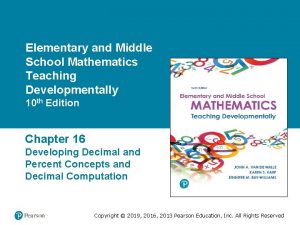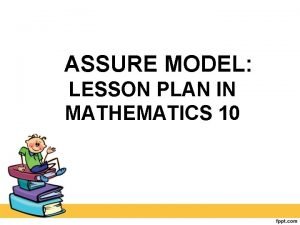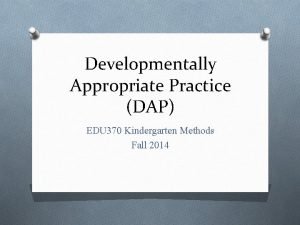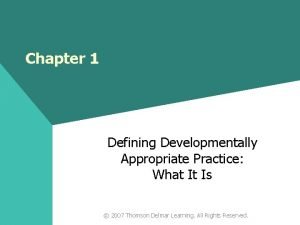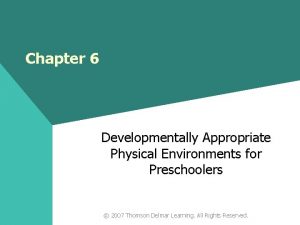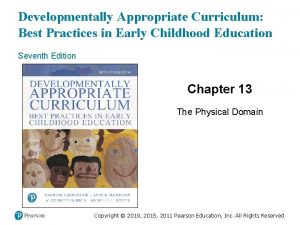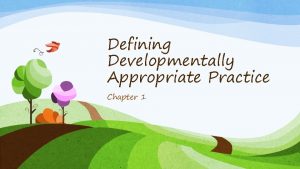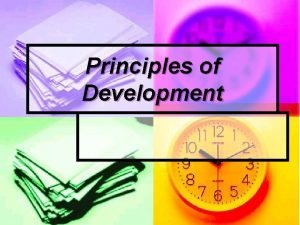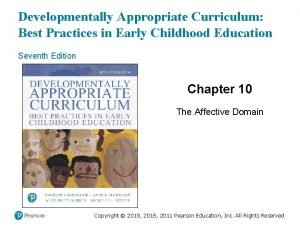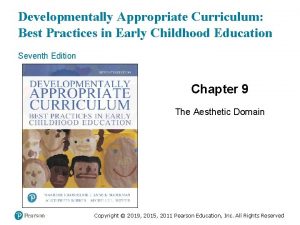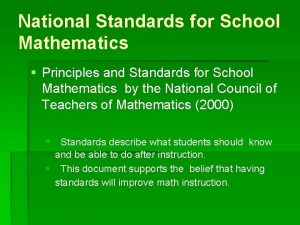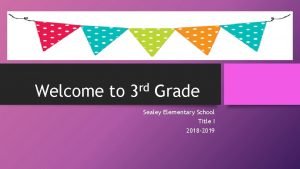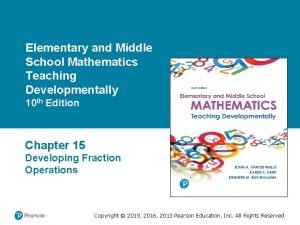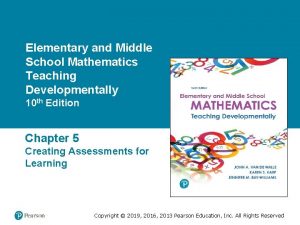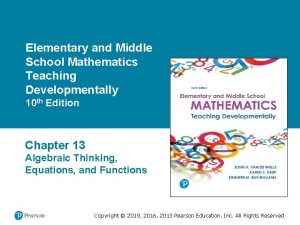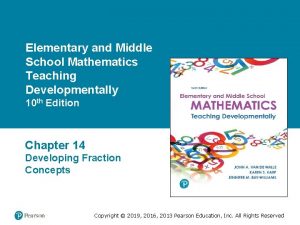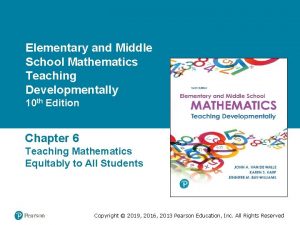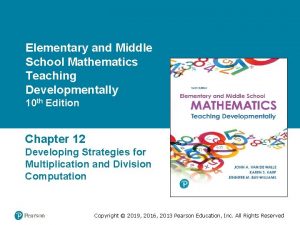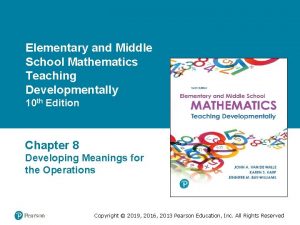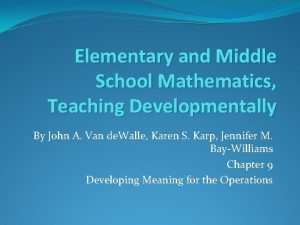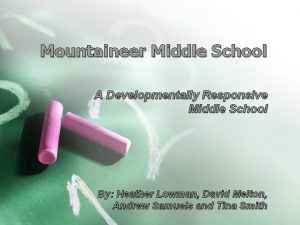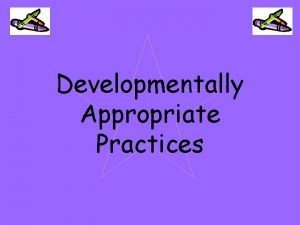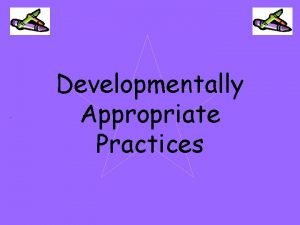Elementary and Middle School Mathematics Teaching Developmentally 10




















- Slides: 20

Elementary and Middle School Mathematics Teaching Developmentally 10 th Edition Chapter 7 Developing Early Number Concepts and Number Sense Copyright © 2019, 2016, 2013 Pearson Education, Inc. All Rights Reserved

Learner Outcomes 7. 1 Recognize that teaching mathematics to very young children involves providing high quality number activities using a developmental approach. 7. 2 Demonstrate how to develop children’s counting skills, including subitizing (immediately recognizing a total number of objects in an organized collection) to three or five without counting each object. 7. 3 Plan ways to teach children to compare quantities and describe relationships between numbers. 7. 4 Develop ways to connect mathematical ideas to the realworld activities of young learners. Copyright © 2019, 2016, 2013 Pearson Education, Inc. All Rights Reserved

Research-Based Recommendations for High-Quality Learning Activities in the First 6 Years of Life 1. Enhance children’s natural interest in mathematics. 2. Build on children’s experience and knowledge. 3. Base mathematics curriculum and teaching practices on solid mathematical knowledge and child development. 4. Use formal and informal experiences to strengthen children’s problem-solving and reasoning processes. 5. Provide opportunities for children to explain their thinking as they interact with the mathematical ideas. 6. Assess children’s mathematical knowledge, skills and strategies through observation and other informal practices. Copyright © 2019, 2016, 2013 Pearson Education, Inc. All Rights Reserved

Standards-Based Development Preschool children: • Counting, one to one correspondence, cardinality and comparing and ordering Kindergarten children: • Count by 100 by ones and tens, count from numbers other than one, write numbers up to 20, make comparisons between groups using greater than, less than or equal to the other First Grade children: • Read and write numbers to 120 including counting from numbers other than one, move to place value concepts relating counting to the operations of addition and subtraction Copyright © 2019, 2016, 2013 Pearson Education, Inc. All Rights Reserved

The Number Core: Quantity, Counting and Cardinality Quantity and the ability to subitize Subitizing - When you look at an amount of objects, sometimes you are able to just “see” how many are there. Activity 7. 1 Materials - Counters, paper plates, dot plates Directions. Hold up dot plate. Make the pattern you saw on this plate with your counters. Then show the plate again as a self-check. (Include zero and what it means when there are no dots. ) Copyright © 2019, 2016, 2013 Pearson Education, Inc. All Rights Reserved

Early Counting the sequence of number words is a rote procedure. • The meaning attached to the counting is the key conceptual idea on which all other number concepts are developed. Research-based learning trajectories provide a path for instructional direction. Verbal counting has at least two separate skills: • Produce the standard string of counting words in order • Connect the sequence in a one-to-one correspondence with objects in the set being counted Copyright © 2019, 2016, 2013 Pearson Education, Inc. All Rights Reserved

Meaning Attached to Counting of Objects In counting, each number identifies a quantity that is one more than the previous number. The new quantity is embedded in the previous quantity Copyright © 2019, 2016, 2013 Pearson Education, Inc. All Rights Reserved

Cardinality Children learn how to count (matching counting words with objects) before they understand that the last word stated in a count indicates the amount of the set. Show a card with 5 -9 large dots, and ask “How many dots are on the card? ” Indicators to watch for: • Child does not count but instead takes out counters and makes a similar pattern. • Child recounts the dots on the card. • Child places the counters in a one-to-one correspondence with the dots on the card. Copyright © 2019, 2016, 2013 Pearson Education, Inc. All Rights Reserved

Numeral Writing and Recognition Reading and writing numerals is similar to teaching them to read and write letters of the alphabet. Mathematics is a language to be learned. Engaging ways: • Make numerals with clay. • Trace numerals in shaving cream. • Write numerals on the interactive whiteboard. • A calculator keypad is a good instructional tool. Copyright © 2019, 2016, 2013 Pearson Education, Inc. All Rights Reserved

Developing Number Sense by Building Number Relationships Spatial Relationships Benchmark numbers 5 and 10 One and Two More/One and Two Less Part-Whole Copyright © 2019, 2016, 2013 Pearson Education, Inc. All Rights Reserved

Make Sets of More/ Less/ Same Children need to construct sets using counters and to make comparisons or choices between two or more sets. Activity 7. 13 Materials - Picture of sets of objects of 4 -12, set of counters, word cards labeled More, Less, Same Directions - Next to each card, have children make three collections. Copyright © 2019, 2016, 2013 Pearson Education, Inc. All Rights Reserved

Number Relationships 1 -10 • Students need to know that 7, for example, is 1 more than 6 and 2 less than 9. • The numbers 5 and 10 play a large role in our numeration system. • Conceptualize a number as being composed of two more parts. Principal tool children will use: Counting skills Copyright © 2019, 2016, 2013 Pearson Education, Inc. All Rights Reserved

Building Relationships Five-Frame Tell-About Materials - Five frame and counters: Ask children to show three on their five-frame. Ask “What can you tell us about looking at your five-frame? ” Accept any answers i. e. space in the middle. Keep giving them numbers and focus on how many more counters needed to make 5. Using a ten frame, try numbers between 5 and 10 in the frame. Copyright © 2019, 2016, 2013 Pearson Education, Inc. All Rights Reserved

Part-Whole Basic Ingredients Compose. • Build designated quantities in two or more parts. Decompose. • Start with a full amount and separate into 2 or more parts. When children read and write the combinations, they focus on the relationships of the parts. Copyright © 2019, 2016, 2013 Pearson Education, Inc. All Rights Reserved

Number Relationships 10 -20 and Beyond A set of 10 plays a major role in the understanding of the numbers 10 -20. Three-level progression of children’s understanding of ten: • Child understands ten as ten ones and does not see ten as a unit. • Child understands ten as a unit but relies on materials to complete tasks involving ten. • A facile concept of ten - Solves tasks without using materials Copyright © 2019, 2016, 2013 Pearson Education, Inc. All Rights Reserved

Ten and Some More Activity 7. 26 Materials – Two-part mat, counters or coffee stirrers, and a story Directions - Ask students to complete the ten frame and count out 7 counters/stirrers on the other side. Have them count all together. Chorus the combination - e. g. , 10 and 7 equal 17 Turn mat around - 7 and 10 equal 17 Repeat with other numbers in random order, but always keep 10 on the left side (e. g. , 5 + 10 = 10 + 5) Work to be able to bundle 10 stirrers together. Copyright © 2019, 2016, 2013 Pearson Education, Inc. All Rights Reserved

Number Sense in Their World Estimation and Measurement - best way for children to think about real quantities Cut out a large footprint 18 inches long. Ask children to tell you about how many will it take to measure the rug in our classroom? • More or less than fill in the blank? • Closer to fill in the blank or to fill in the blank? • About fill in the blank? Connecting numbers to real situations - Activity 7. 28 and 7. 29 Suggest units to use with a number nine fill in the blank. Also give a number and unit and figure out when that would be reasonable-15 feet. Copyright © 2019, 2016, 2013 Pearson Education, Inc. All Rights Reserved

Represent and Interpret Data Encourage children to generate ideas for what data to gather. Use the graphed data to compare number relationships rather than only referencing more and less. For instance, • More students brought apples for snack than bananas. • Three less people brought oranges than brought apples. • Three more people brought oranges than brought bananas. Copyright © 2019, 2016, 2013 Pearson Education, Inc. All Rights Reserved

Common Errors and Misconceptions: Early Number Concepts (1 of 2) Concept Child does not understand the cardinality principle. What it looks like: When asked “How many? ”, the child recounts all the objects or points to last object counted How to Help Provide lots of counting opportunities, followed by asking “How many? ” When counting collections together, say, “ 1, 2, 3, 4, 5”. We have 5 pencils. ” Copyright © 2019, 2016, 2013 Pearson Education, Inc. All Rights Reserved

Common Errors and Misconceptions: Early Number Concepts (2 of 2) 1. Does not know the counting sequence 2. Counts without using one-to-one correspondence 3. Does not count on 4. Difficulty counting the teen numbers or decade numbers 5. Writes the numeral backwards or reverses the digits in the teen numbers 6. Not sure of the magnitude of numbers from 1 -20 Copyright © 2019, 2016, 2013 Pearson Education, Inc. All Rights Reserved
 Elementary and middle school mathematics 10th edition
Elementary and middle school mathematics 10th edition Dpscd.schoology.com
Dpscd.schoology.com Assure model lesson plan
Assure model lesson plan Japanese kindergarten uniform yellow hat
Japanese kindergarten uniform yellow hat Utilitarian aims of teaching mathematics
Utilitarian aims of teaching mathematics Teacher dominated approach
Teacher dominated approach Macro teaching is a scaled down teaching
Macro teaching is a scaled down teaching Dap kindergarten
Dap kindergarten Describe developmentally appropriate practice
Describe developmentally appropriate practice Developmentally appropriate environment
Developmentally appropriate environment Developmentally appropriate curriculum 7th edition
Developmentally appropriate curriculum 7th edition Define developmentally appropriate practice
Define developmentally appropriate practice Principles of developmentally appropriate practice
Principles of developmentally appropriate practice Developmentally appropriate curriculum 7th edition
Developmentally appropriate curriculum 7th edition Developmentally appropriate curriculum 7th edition
Developmentally appropriate curriculum 7th edition Principles and standards for school mathematics
Principles and standards for school mathematics Holland middle school track and field
Holland middle school track and field Ubujan elementary school
Ubujan elementary school William beanes elementary school
William beanes elementary school Mckay elementary school
Mckay elementary school Sealey elementary
Sealey elementary
